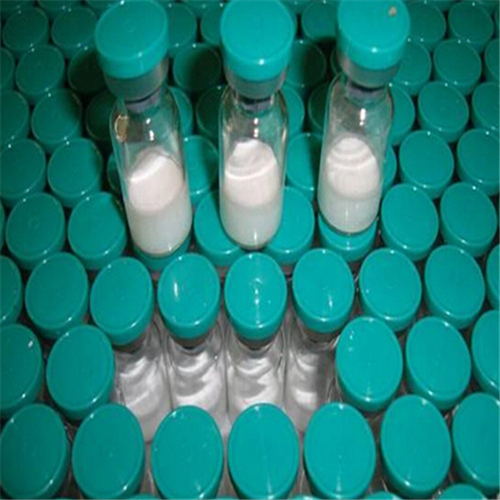MGF Powder Peptide Mechano Growth Factor API
MGF Peptide Basic Info:
Adequado para: Idoso, Adulto
Pureza: >99%
Aparência: Pó branco
Fórmula molecular: C121h200n42o39
Peso molecular: 2867.14
Nota: Farmacêutico
Mass Balance: 95.0~105.0%
Single Inpurity: <0.5%
Water Content: <8%
Acetate Content(HPLC): <10%
MGF Peptide Product Description
Loss of muscle mass in old age and in certain diseases is associated with an impaired ability to express MGF.
– The ability to produce MGF declines with age, and this is commensurate with the decline in circulating GH levels.
– MGF has been shown to boost muscle mass by improving the ability of wasted tissue to grow.
– MGF has been shown to improve the ability of wasted tissue to grow.
– MGF has been shown to activate muscle stem cells.
– MGF has been shown to increase the upregulation of protein synthesis.
– MGF induces rapid muscle hypertrophy.
– MGF has considerable potential as a generic means of treating muscle cachexia.
– Mechano Factor (MGF) targets skeletal tissue, and promotes muscle growth by repairing the damaged tissue and upregulating protein synthesis.
The sequencing of the human genome showed that there are only about 40,000 genes. No entanto, there are many more proteins. This is because some genes are spliced to produce different protein/peptides which usually have different biological functions. Combining physiological and molecular biology methods made it possible to identify and characterize a local muscle growth/repair factor (MGF).
MGF also known as IGF-1Ec is a that is derived from exercised or damaged muscle tissue. MGF has been shown to boost muscle mass by improving the ability of wasted tissue to grow and improve itself by activating muscle stem cells and increasing the upregulation of protein synthesis. MGF is a part of the IGF family, but, in the case of MGF, this part of the peptide acts as a separate growth factor involved in initiating muscle satellite (stem) cell activation in addition to its IGF-Ireceptor domain which increases protein synthesis, and hence improves muscle mass
What makes MGF special is its’ unique role in muscle growth. MGF has the ability to cause wasted tissue to grow and improve by activating muscle stem cells and increasing the upregulation of protein synthesis, this unique ability can rapidly improve recovery and speed up muscle growth. MGF can initiate muscle satellite (stem) cell activation in addition to its IGF-1 receptor domain which, in turn, increases protein synthesis turnover; therefore, if used correctly it can improve muscle mass over time.
The liver produces 2 kinds of MGF splice variants of IGF
1) IGF-1Ec: This is the first phase release igf splice variant and it appears to stimulate satellite cells into activation, This is the closest variant to synthetic MGF.
2) Liver type IGF-IEa: this is the secondary release of igf from the liver, and its far less anabolic.
MGF vs IGF-IEa
Fig 1. MGF vs. IGF-IEa
MGF differs from the second variant IGF-IEa as it has a different peptide sequence which is responsible for replenishing the satellite cells in skeletal muscle; em outras palavras, it is more anabolic and longer acting than the systematic release of the second MGF liver variant.
So just think of MGF as a highly anabolic variant of igf. After you have trained, the IGF-I gene is spliced towards MGF then that causes hypertrophy and repair of local muscle damage by activating the muscle stem cells as well as other important anabolic processes, including the above mentioned protein synthesis, and increased nitrogen retention.
In rats, some studies have shown muscle mass increases of 20 percent from a single MGF injection, but somehow I think many of these studies are not accurate, however the potential is undeniable.
HOW TO USE MGF
When you train, what happens to your muscles is they break down, the cells are damaged, muscle tissue needs to be repaired and your body produces 2 forms of MGF splice variant. The first initial release of the above mentioned number 1 variant from the liver helps muscle cell recovery, if there is no MGF then muscle cells die.
As muscle is a post-mitotic tissue and as such cell replacement is not a means of tissue repair, if the cells are not repaired they die and your muscles get smaller and weaker. In muscle tissue, the pool of these stem cells is apparently replenished by the action of MGF, which is produced as a pulse following damage.
Now, with synthetic injections of MGF you can increase the pulse and so speed up recovery, and increase the muscle tissue cells by stimulating satellite cells into full maturity. In terms of dosages, 200mcg bi-laterally is the very best choice of dosing in muscles trained.
The only problem with MGF, and this is the reason I don’t like it, is that it has such a short half life, just a few minutes, between 5-7, and it needs to be used immediately post workout as it wont work if muscle tissue hasn’t been damaged. That’s why, for me personally, I think the best option is PEG MGF.
Nevertheless, MGF has a huge role to play, and is administered to those with muscle wasting diseases and for those who are elderly and have lost muscle mass for good reason, it is EXTREMELY anabolic.









